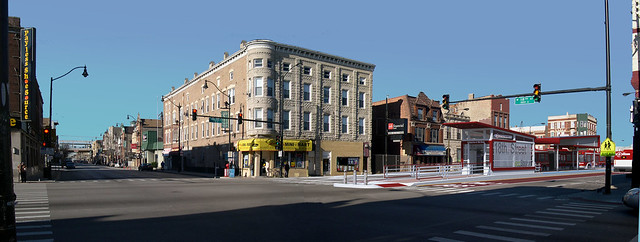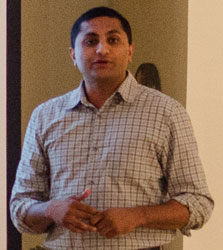Ashland Avenue BRT could be a transformative project for Chicago, demonstrating the benefits of re-orienting streets to prioritize transit and walking. Projected to nearly double bus speeds, improve reliability, attract new riders, and improve pedestrian safety, Ashland BRT could potentially be the first world-class bus project in America, designed to a standard that would receive the top BRT rating from the Institute for Transportation and Development Policy.
First the busway has to get built. The first phase will convert two travel lanes to bus-only lanes from Cortland Street to 31st Street, linking wards 32, 2, 1, 27, 28, and 25 (using the 2015 map). Future phases will include other wards, including the 47th ward, where alderman Ameya Pawar enthusiastically supports the project.
While the project would make it easier and safer for their constituents to get around without a car, keeping thousands of dollars in their pocket, the aldermen Streetsblog spoke to are taking noncommittal positions so far. Except for Pawar, who remains strongly in favor of BRT.
Here's what four aldermen told us about Ashland bus rapid transit.
Walter Burnett (27th)
Of the four aldermen who spoke to Streetsblog, Burnett was the least enthused about BRT. "At this time, I'm not" in support of the proposal, Burnett said in a phone interview. That could change, but he indicated that his support would be conditional. Burnett noted that businesses along the corridor are concerned with the left turn prohibitions, saying "it's really gonna jeopardize those businesses." Despite the dire predictions, trucks will still be able to access those businesses -- in fact global delivery companies like UPS minimize the number of left turns in their routing to save time and gas.
Burnett also thinks bus rapid transit will interfere with events at the United Center. "When events at the United Center go on, they block off a lot of streets. The BRT would hinder all of that blockage that they do there," Burnett told me. But Ashland BRT will provide the rapid transit to the United Center that many people have been calling for in the form of a Pink Line L stop, and it will cut down on game-day driving, reducing congestion and changing up how the temporary street closures are currently implemented.
While Burnett is open to the project, he did not mention that improving transit and creating a better pedestrian street is important. "I'm gonna let the CTA listen to these concerns and make some adjustments before I make a decision," he said, "and so far they haven't done that."
Proco "Joe" Moreno (1st)
Moreno hasn't taken a position yet, but his office refrained from criticizing aspects of the proposal. Matt Bailey, communications director for the 1st Ward, pointed me to a newsletter last week where Moreno wrote:
I am currently neutral on the plan. At this stage, I think it is helpful to let both sides discuss (and they do vigorously) and hopefully find common ground.
"We're not really taking a stand right now," said Bailey, even though "we have personal opinions on the matter."
He did not mention specific benefits of the proposal. Notably, though, Bailey acknowledged the inherent challenge of changing the status quo on the streets. "People don't tend to call if they support something." He said there've been a lot of phone calls from residents opposing the project but recognizes that this isn't "really a good metric to measure anything, necessarily." (See also: Machiavelli's thoughts on introducing a new order of things.)
Moreno might hold a ward-specific meeting, Bailey said, although the alderman and his staff members have been attending the community meetings hosted by neighborhood organizations with presentations from CTA officials.
Scott Waguespack (32nd)
Chief of Staff Paul Sajovec said that Waguespack has "pretty serious concerns about the business implications, primarily with their ability to do loading and unloading" and feels that there's been little outreach. Sajovec said that "no one's explained to the businesses how they're going to get their deliveries in the alley" when Ashland is narrowed to one travel lane. He said that with only one lane of traffic, "trucks may not fit neatly into the parking lane and may shut down traffic." The alderman would like to see some of the businesses' input incorporated before CTA and CDOT make a decision on the final lane configurations, and define where loading/unloading should take place.
It should be noted that if Ashland BRT is built, curb access for deliveries will be no different than today's conditions, when beer delivery trucks park in front of Ashland stores. Truck deliveries don't cause chaos on two-lane streets like Halsted, Damen or Milwaukee. Curb access issues are surmountable and should be addressed with better enforcement and loading zone management, not forgoing gold standard BRT. Plus, while the rules governing use of the bus lanes have yet to be worked out, in other places, such as New York, drivers are allowed to use bus lanes to bypass stationary obstacles, just not slow traffic or garbage trucks.
Sajovec also mentioned that some residents are worried about the impact on traffic: "How can you possibly go down from two lanes to one?" He added that people who drive on Ashland now may be affected because the number of turning movements is restricted and "we haven't seen anything on where or how that's going to happen." While the full traffic analysis has yet to be released, the basic reasons traffic won't be markedly affected have been explained at various public events. Some trips will shift to transit, others will be absorbed by Chicago's robust street grid, and as ITDP's Walter Hook noted at a recent forum, left-turn restrictions alleviate congestion, and the dedicated bus lanes will eliminate much of the bus merging that currently delays traffic on Ashland.
Sajovec did acknowledge that if a lot of people use the Ashland bus rapid transit line, that "will be a more efficient way to move people from A to B than everyone being in their cars." That was the closest he came to saying that this project will benefit the city.
Ameya Pawar (47th)
I summarized for Pawar over the phone what the three other aldermen said about BRT. "Those are all fair positions," he said. "My position is that I'm really excited about it." Pawar reiterated his thoughts, previously posted on his Facebook page, that Chicago has a lot of traffic congestion and long commute times, but "you can't widen [Ashland]." He said "the only way you can help the city grow over the long term, address climate change, reduce carbon emissions... we're going to need great bus rapid transit."
He thinks that many people have rushed to judgment on the project. With many details still unavailable, he said he awaits the CTA's upcoming environmental analysis. Pawar said the process must be respected, adding, "everyone's opinion matters and ultimately what we want to get to is make the best BRT solution that gets people around the city quickly." He said he's looking forward to a plan that addresses spillover traffic and the left-turn concerns.
CTA spokesperson Lambrini Lukidis said the agency would continue its constant talks with aldermen and attending neighborhood-hosted meetings. "As we incorporate more feedback, that will influence the final design," she said. A public meeting will be scheduled soon at which CTA will present its Environmental Assessment that explains all the data CTA and CDOT are using in their traffic, parking, and noise impact analyses.
The offices of aldermen Danny Solis (25), Jason Ervin (28), and Rob Fioretti (2), did not return calls for comment.






